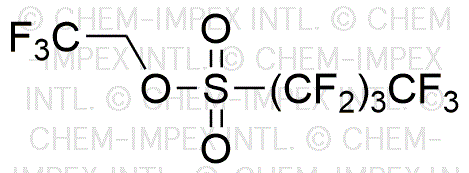2,2,2-Trifluoroethyl nonafluorobutanesulfonate is widely utilized in research focused on:
- Fluorinated Surfactants: This compound serves as a highly effective surfactant in various applications, including oil recovery and emulsification processes, due to its unique fluorinated structure that enhances surface activity.
- Analytical Chemistry: It is used as a reagent in analytical chemistry for the detection and quantification of various compounds, providing high sensitivity and specificity in complex mixtures.
- Pharmaceutical Development: The compound plays a role in drug formulation, particularly in enhancing the solubility and bioavailability of active pharmaceutical ingredients, making it valuable in the pharmaceutical industry.
- Environmental Studies: Its application in environmental science helps in studying the behavior of fluorinated compounds in ecosystems, aiding in the assessment of environmental impact and safety.
- Material Science: This chemical is utilized in the development of advanced materials, including coatings and polymers, that require exceptional chemical resistance and durability, outperforming traditional non-fluorinated alternatives.
General Information
Properties
Safety and Regulations
Applications
2,2,2-Trifluoroethyl nonafluorobutanesulfonate is widely utilized in research focused on:
- Fluorinated Surfactants: This compound serves as a highly effective surfactant in various applications, including oil recovery and emulsification processes, due to its unique fluorinated structure that enhances surface activity.
- Analytical Chemistry: It is used as a reagent in analytical chemistry for the detection and quantification of various compounds, providing high sensitivity and specificity in complex mixtures.
- Pharmaceutical Development: The compound plays a role in drug formulation, particularly in enhancing the solubility and bioavailability of active pharmaceutical ingredients, making it valuable in the pharmaceutical industry.
- Environmental Studies: Its application in environmental science helps in studying the behavior of fluorinated compounds in ecosystems, aiding in the assessment of environmental impact and safety.
- Material Science: This chemical is utilized in the development of advanced materials, including coatings and polymers, that require exceptional chemical resistance and durability, outperforming traditional non-fluorinated alternatives.
Documents
Safety Data Sheets (SDS)
The SDS provides comprehensive safety information on handling, storage, and disposal of the product.
Product Specification (PS)
The PS provides a comprehensive breakdown of the product’s properties, including chemical composition, physical state, purity, and storage requirements. It also details acceptable quality ranges and the product's intended applications.
Certificates of Analysis (COA)
Search for Certificates of Analysis (COA) by entering the products Lot Number. Lot and Batch Numbers can be found on a product’s label following the words ‘Lot’ or ‘Batch’.
*Catalog Number
*Lot Number
Certificates Of Origin (COO)
This COO confirms the country where the product was manufactured, and also details the materials and components used in it and whether it is derived from natural, synthetic, or other specific sources. This certificate may be required for customs, trade, and regulatory compliance.
*Catalog Number
*Lot Number
Safety Data Sheets (SDS)
The SDS provides comprehensive safety information on handling, storage, and disposal of the product.
DownloadProduct Specification (PS)
The PS provides a comprehensive breakdown of the product’s properties, including chemical composition, physical state, purity, and storage requirements. It also details acceptable quality ranges and the product's intended applications.
DownloadCertificates of Analysis (COA)
Search for Certificates of Analysis (COA) by entering the products Lot Number. Lot and Batch Numbers can be found on a product’s label following the words ‘Lot’ or ‘Batch’.
*Catalog Number
*Lot Number
Certificates Of Origin (COO)
This COO confirms the country where the product was manufactured, and also details the materials and components used in it and whether it is derived from natural, synthetic, or other specific sources. This certificate may be required for customs, trade, and regulatory compliance.

